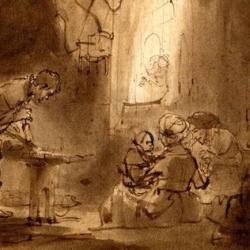In his monograph on Israel’s Tabernacle as Social Space, Mark George makes the observation that tabernacle space is “configured horizontally”: “There is not a single step, platform, or dais in tabernacle space. No steps differentiate court space from common space, holy space from court space, or most holy space from holy space. There are not steps up to the burnt altar or incense altar. The only possible raised space within the entire tabernacle complex is the place where the deity meets Moses, the kapporet over the ark. . . Yet even if this does constitute a raised space, it is the space occupied by the deity alone, indicating the privileging of the deity, not another human being” (128-9).
This runs counter to the symbolism of hierarchy throughout much of the ancient world, including ancient Israel: “Scholars have shown that a number of cultures represent social hierarchies through vertical classification schemas (see Plato’s Republic and Timaeus, and the Chandogya Upanishads). The ancient Near East is no exception, including Israel and the Hebrew Bible. In Ugarit, Baal’s throne rests on a gold-covered silver dais, realizing the status of his position through vertical elevation. . . . Moses meets with the deity at the top of the mountain . . . while the people are to remain at the foot of the mountain unless explicitly summoned. . . . Ezekiel’s temple vision operates by way of vertical classification, with elevation playing a subtle but important role in the mapping of that social space” (128).
George muses inconclusively on the significance of this fact. What is up here? It won’t do to chalk it up to the impracticality of making a multi-story tent; if Yahweh didn’t want a flat house with horizontal hierarchy, He could have waited til later to tell Israel to build Him a house. Whatever is going on here, it’s not a simple egalitarianism: As George points out, there is a hierarchy, marked out by curtains and screens, moving from west to east (the tabernacle instructions, he points out, begin at the “western” end, 133).
I will muse inconclusively as well, and suggest two possible angles. The first, comparatively obvious, one is that the tabernacle is indeed a the arrival of the God of Israel into human space. He is “up,” but He comes “down” so that He can be “over there” rather than “up there.” Yahweh comes to be a king in the horizontal social space of Israel. And, thinking typologically, this is preview and preparation for His fuller arrival in our space when He tabernacles in flesh.
The second, more opaque suggestion, is that the horizontalization of hierarchy might indicate a temporalization of hierarchy. That is, the tabernacle is set up as sacred space but gestures toward sacred time. Sacred space and Sabbath overlap in the Pentateuch (see Morales, The Tabernacle Pre-Figured; reflecting on Sabbath as the end of creation, Morales nicely states, that “God created a palace in time,” 92). The orientation of the tabernacle along an east-west axis might fit here: The open court is to the east, toward sunrising, and the inner sanctuary, the hidden gifts of Yahweh, are in the west, toward sunset, accessible only to those who have become “men of future,” eschatological men, Last Men, by their rite of (ful)filling. They are the perfect men, glorified in glorious robes, who enter already into the future. And then we should think typologically about that too.














